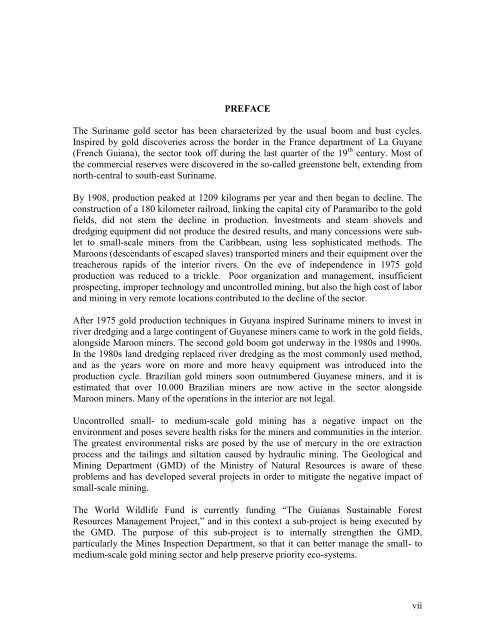SITUATION ANALYSIS OF THE SMALL-SCALE GOLD ... - WWF
SITUATION ANALYSIS OF THE SMALL-SCALE GOLD ... - WWF
SITUATION ANALYSIS OF THE SMALL-SCALE GOLD ... - WWF
You also want an ePaper? Increase the reach of your titles
YUMPU automatically turns print PDFs into web optimized ePapers that Google loves.
PREFACE<br />
The Suriname gold sector has been characterized by the usual boom and bust cycles.<br />
Inspired by gold discoveries across the border in the France department of La Guyane<br />
(French Guiana), the sector took off during the last quarter of the 19 th century. Most of<br />
the commercial reserves were discovered in the so-called greenstone belt, extending from<br />
north-central to south-east Suriname.<br />
By 1908, production peaked at 1209 kilograms per year and then began to decline. The<br />
construction of a 180 kilometer railroad, linking the capital city of Paramaribo to the gold<br />
fields, did not stem the decline in production. Investments and steam shovels and<br />
dredging equipment did not produce the desired results, and many concessions were sublet<br />
to small-scale miners from the Caribbean, using less sophisticated methods. The<br />
Maroons (descendants of escaped slaves) transported miners and their equipment over the<br />
treacherous rapids of the interior rivers. On the eve of independence in 1975 gold<br />
production was reduced to a trickle. Poor organization and management, insufficient<br />
prospecting, improper technology and uncontrolled mining, but also the high cost of labor<br />
and mining in very remote locations contributed to the decline of the sector.<br />
After 1975 gold production techniques in Guyana inspired Suriname miners to invest in<br />
river dredging and a large contingent of Guyanese miners came to work in the gold fields,<br />
alongside Maroon miners. The second gold boom got underway in the 1980s and 1990s.<br />
In the 1980s land dredging replaced river dredging as the most commonly used method,<br />
and as the years wore on more and more heavy equipment was introduced into the<br />
production cycle. Brazilian gold miners soon outnumbered Guyanese miners, and it is<br />
estimated that over 10.000 Brazilian miners are now active in the sector alongside<br />
Maroon miners. Many of the operations in the interior are not legal.<br />
Uncontrolled small- to medium-scale gold mining has a negative impact on the<br />
environment and poses severe health risks for the miners and communities in the interior.<br />
The greatest environmental risks are posed by the use of mercury in the ore extraction<br />
process and the tailings and siltation caused by hydraulic mining. The Geological and<br />
Mining Department (GMD) of the Ministry of Natural Resources is aware of these<br />
problems and has developed several projects in order to mitigate the negative impact of<br />
small-scale mining.<br />
The World Wildlife Fund is currently funding “The Guianas Sustainable Forest<br />
Resources Management Project,” and in this context a sub-project is being executed by<br />
the GMD. The purpose of this sub-project is to internally strengthen the GMD,<br />
particularly the Mines Inspection Department, so that it can better manage the small- to<br />
medium-scale gold mining sector and help preserve priority eco-systems.<br />
vii
















